Law Assignment: Sale of Goods and Consumer Protection, Unit 9
VerifiedAdded on 2022/09/16
|13
|3265
|21
Homework Assignment
AI Summary
This assignment delves into several areas of Canadian law, starting with the Sale of Goods Act and consumer protection. It examines a technology company's considerations when entering purchase agreements and sales contracts. The assignment also analyzes the Canada Consumer Product Safety Act concerning dangerous products like "killer candies" and suggests additional safety measures. Furthermore, it explores compliance costs, the principle of caveat emptor, and the importance of ethical business transactions. The document then addresses a lawyer's duties in property transactions, including financing options like debt and equity financing. It compares and contrasts mortgage cases, focusing on the mortgagee's responsibilities and the importance of fair market value. Finally, the assignment discusses patent law, outlining the criteria for obtaining a patent to protect a pharmaceutical company's newly developed medical product. The document provides comprehensive legal analysis and application to the given scenarios.
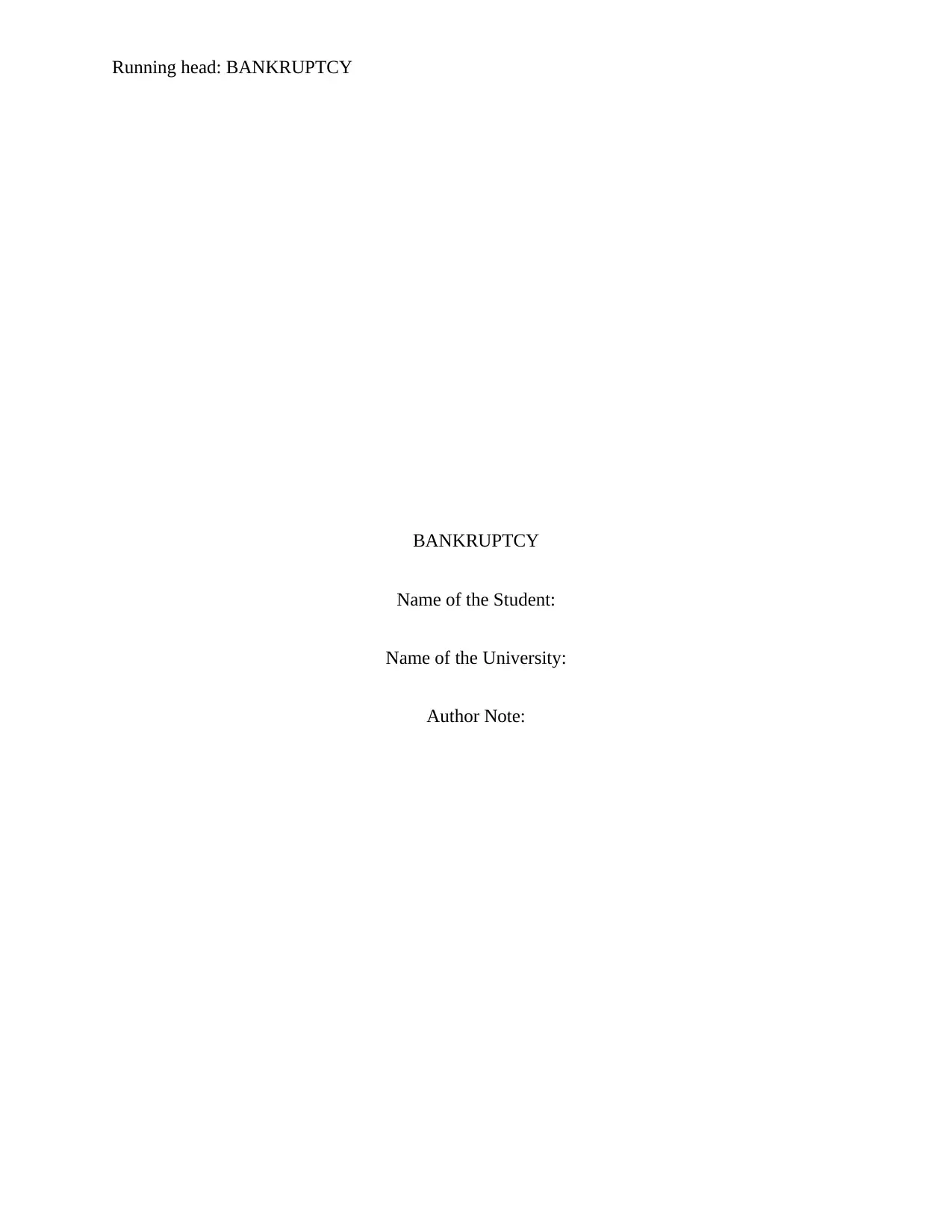
Running head: BANKRUPTCY
BANKRUPTCY
Name of the Student:
Name of the University:
Author Note:
BANKRUPTCY
Name of the Student:
Name of the University:
Author Note:
Paraphrase This Document
Need a fresh take? Get an instant paraphrase of this document with our AI Paraphraser
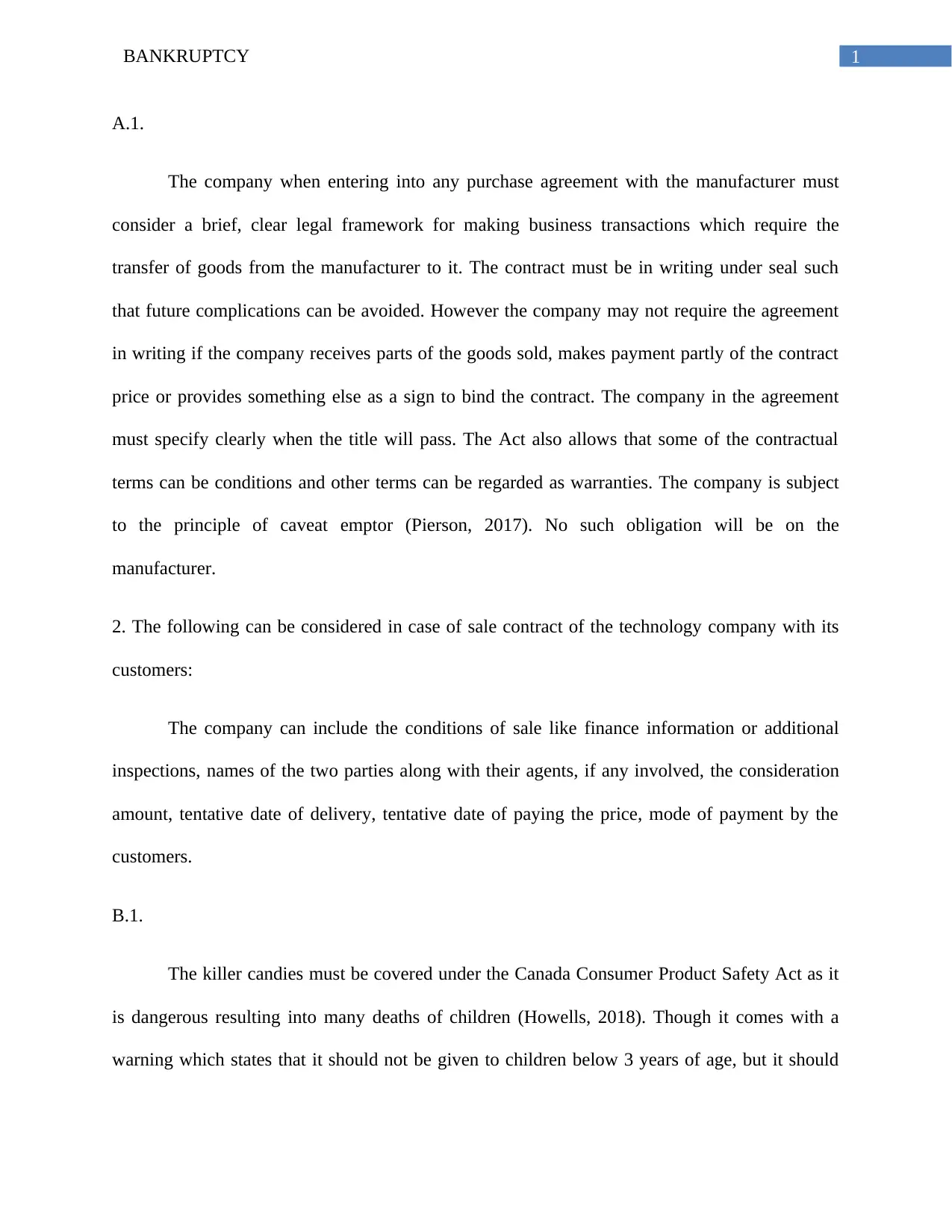
1BANKRUPTCY
A.1.
The company when entering into any purchase agreement with the manufacturer must
consider a brief, clear legal framework for making business transactions which require the
transfer of goods from the manufacturer to it. The contract must be in writing under seal such
that future complications can be avoided. However the company may not require the agreement
in writing if the company receives parts of the goods sold, makes payment partly of the contract
price or provides something else as a sign to bind the contract. The company in the agreement
must specify clearly when the title will pass. The Act also allows that some of the contractual
terms can be conditions and other terms can be regarded as warranties. The company is subject
to the principle of caveat emptor (Pierson, 2017). No such obligation will be on the
manufacturer.
2. The following can be considered in case of sale contract of the technology company with its
customers:
The company can include the conditions of sale like finance information or additional
inspections, names of the two parties along with their agents, if any involved, the consideration
amount, tentative date of delivery, tentative date of paying the price, mode of payment by the
customers.
B.1.
The killer candies must be covered under the Canada Consumer Product Safety Act as it
is dangerous resulting into many deaths of children (Howells, 2018). Though it comes with a
warning which states that it should not be given to children below 3 years of age, but it should
A.1.
The company when entering into any purchase agreement with the manufacturer must
consider a brief, clear legal framework for making business transactions which require the
transfer of goods from the manufacturer to it. The contract must be in writing under seal such
that future complications can be avoided. However the company may not require the agreement
in writing if the company receives parts of the goods sold, makes payment partly of the contract
price or provides something else as a sign to bind the contract. The company in the agreement
must specify clearly when the title will pass. The Act also allows that some of the contractual
terms can be conditions and other terms can be regarded as warranties. The company is subject
to the principle of caveat emptor (Pierson, 2017). No such obligation will be on the
manufacturer.
2. The following can be considered in case of sale contract of the technology company with its
customers:
The company can include the conditions of sale like finance information or additional
inspections, names of the two parties along with their agents, if any involved, the consideration
amount, tentative date of delivery, tentative date of paying the price, mode of payment by the
customers.
B.1.
The killer candies must be covered under the Canada Consumer Product Safety Act as it
is dangerous resulting into many deaths of children (Howells, 2018). Though it comes with a
warning which states that it should not be given to children below 3 years of age, but it should
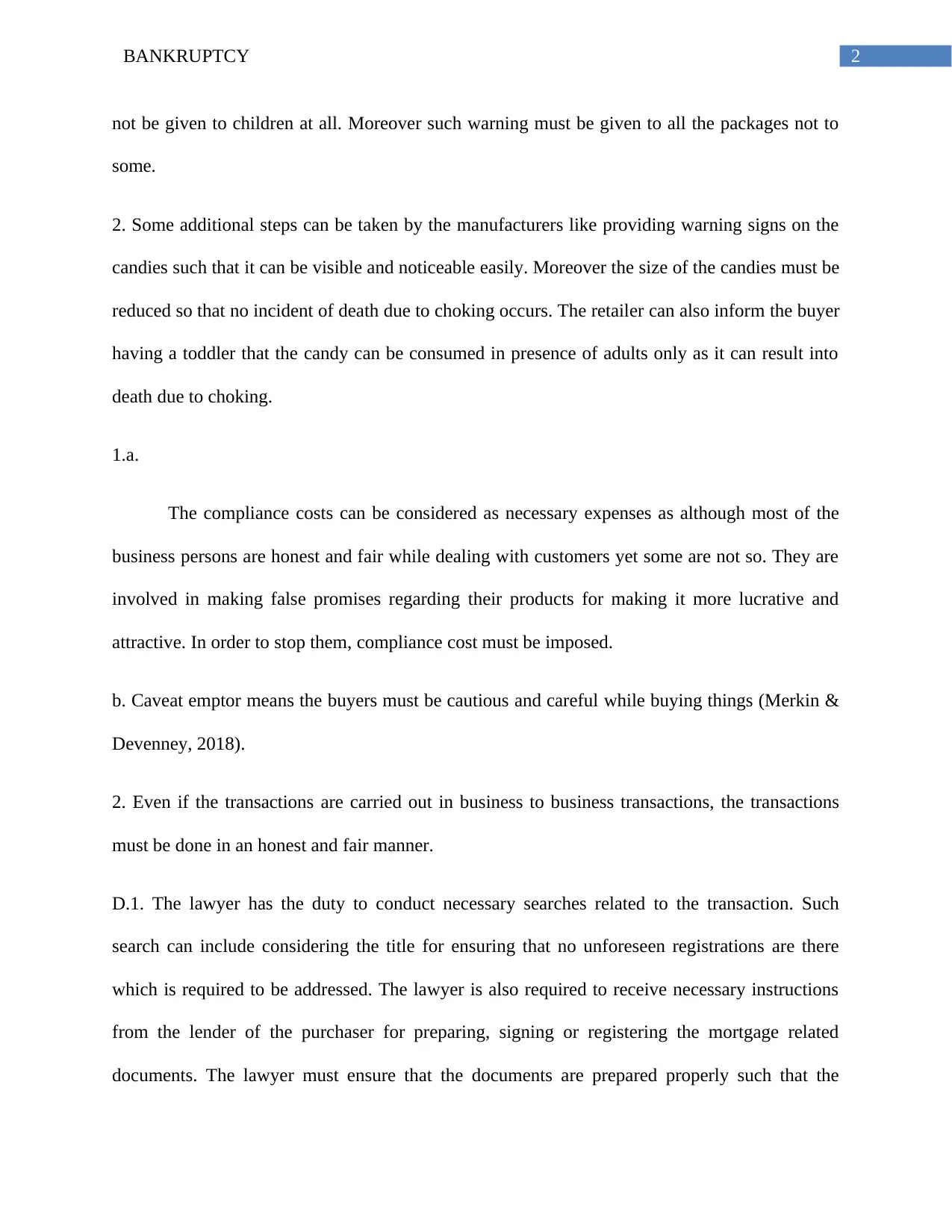
2BANKRUPTCY
not be given to children at all. Moreover such warning must be given to all the packages not to
some.
2. Some additional steps can be taken by the manufacturers like providing warning signs on the
candies such that it can be visible and noticeable easily. Moreover the size of the candies must be
reduced so that no incident of death due to choking occurs. The retailer can also inform the buyer
having a toddler that the candy can be consumed in presence of adults only as it can result into
death due to choking.
1.a.
The compliance costs can be considered as necessary expenses as although most of the
business persons are honest and fair while dealing with customers yet some are not so. They are
involved in making false promises regarding their products for making it more lucrative and
attractive. In order to stop them, compliance cost must be imposed.
b. Caveat emptor means the buyers must be cautious and careful while buying things (Merkin &
Devenney, 2018).
2. Even if the transactions are carried out in business to business transactions, the transactions
must be done in an honest and fair manner.
D.1. The lawyer has the duty to conduct necessary searches related to the transaction. Such
search can include considering the title for ensuring that no unforeseen registrations are there
which is required to be addressed. The lawyer is also required to receive necessary instructions
from the lender of the purchaser for preparing, signing or registering the mortgage related
documents. The lawyer must ensure that the documents are prepared properly such that the
not be given to children at all. Moreover such warning must be given to all the packages not to
some.
2. Some additional steps can be taken by the manufacturers like providing warning signs on the
candies such that it can be visible and noticeable easily. Moreover the size of the candies must be
reduced so that no incident of death due to choking occurs. The retailer can also inform the buyer
having a toddler that the candy can be consumed in presence of adults only as it can result into
death due to choking.
1.a.
The compliance costs can be considered as necessary expenses as although most of the
business persons are honest and fair while dealing with customers yet some are not so. They are
involved in making false promises regarding their products for making it more lucrative and
attractive. In order to stop them, compliance cost must be imposed.
b. Caveat emptor means the buyers must be cautious and careful while buying things (Merkin &
Devenney, 2018).
2. Even if the transactions are carried out in business to business transactions, the transactions
must be done in an honest and fair manner.
D.1. The lawyer has the duty to conduct necessary searches related to the transaction. Such
search can include considering the title for ensuring that no unforeseen registrations are there
which is required to be addressed. The lawyer is also required to receive necessary instructions
from the lender of the purchaser for preparing, signing or registering the mortgage related
documents. The lawyer must ensure that the documents are prepared properly such that the
⊘ This is a preview!⊘
Do you want full access?
Subscribe today to unlock all pages.

Trusted by 1+ million students worldwide
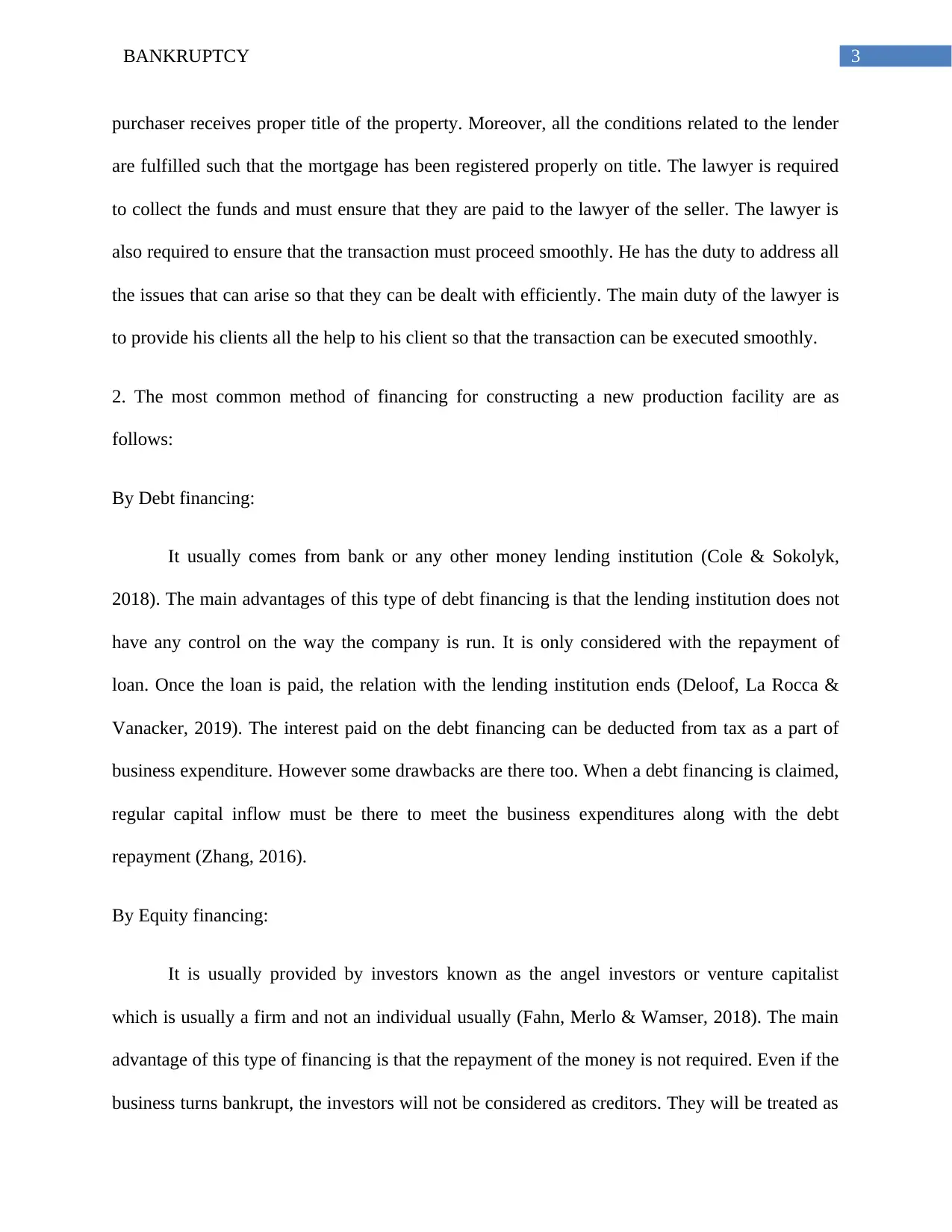
3BANKRUPTCY
purchaser receives proper title of the property. Moreover, all the conditions related to the lender
are fulfilled such that the mortgage has been registered properly on title. The lawyer is required
to collect the funds and must ensure that they are paid to the lawyer of the seller. The lawyer is
also required to ensure that the transaction must proceed smoothly. He has the duty to address all
the issues that can arise so that they can be dealt with efficiently. The main duty of the lawyer is
to provide his clients all the help to his client so that the transaction can be executed smoothly.
2. The most common method of financing for constructing a new production facility are as
follows:
By Debt financing:
It usually comes from bank or any other money lending institution (Cole & Sokolyk,
2018). The main advantages of this type of debt financing is that the lending institution does not
have any control on the way the company is run. It is only considered with the repayment of
loan. Once the loan is paid, the relation with the lending institution ends (Deloof, La Rocca &
Vanacker, 2019). The interest paid on the debt financing can be deducted from tax as a part of
business expenditure. However some drawbacks are there too. When a debt financing is claimed,
regular capital inflow must be there to meet the business expenditures along with the debt
repayment (Zhang, 2016).
By Equity financing:
It is usually provided by investors known as the angel investors or venture capitalist
which is usually a firm and not an individual usually (Fahn, Merlo & Wamser, 2018). The main
advantage of this type of financing is that the repayment of the money is not required. Even if the
business turns bankrupt, the investors will not be considered as creditors. They will be treated as
purchaser receives proper title of the property. Moreover, all the conditions related to the lender
are fulfilled such that the mortgage has been registered properly on title. The lawyer is required
to collect the funds and must ensure that they are paid to the lawyer of the seller. The lawyer is
also required to ensure that the transaction must proceed smoothly. He has the duty to address all
the issues that can arise so that they can be dealt with efficiently. The main duty of the lawyer is
to provide his clients all the help to his client so that the transaction can be executed smoothly.
2. The most common method of financing for constructing a new production facility are as
follows:
By Debt financing:
It usually comes from bank or any other money lending institution (Cole & Sokolyk,
2018). The main advantages of this type of debt financing is that the lending institution does not
have any control on the way the company is run. It is only considered with the repayment of
loan. Once the loan is paid, the relation with the lending institution ends (Deloof, La Rocca &
Vanacker, 2019). The interest paid on the debt financing can be deducted from tax as a part of
business expenditure. However some drawbacks are there too. When a debt financing is claimed,
regular capital inflow must be there to meet the business expenditures along with the debt
repayment (Zhang, 2016).
By Equity financing:
It is usually provided by investors known as the angel investors or venture capitalist
which is usually a firm and not an individual usually (Fahn, Merlo & Wamser, 2018). The main
advantage of this type of financing is that the repayment of the money is not required. Even if the
business turns bankrupt, the investors will not be considered as creditors. They will be treated as
Paraphrase This Document
Need a fresh take? Get an instant paraphrase of this document with our AI Paraphraser
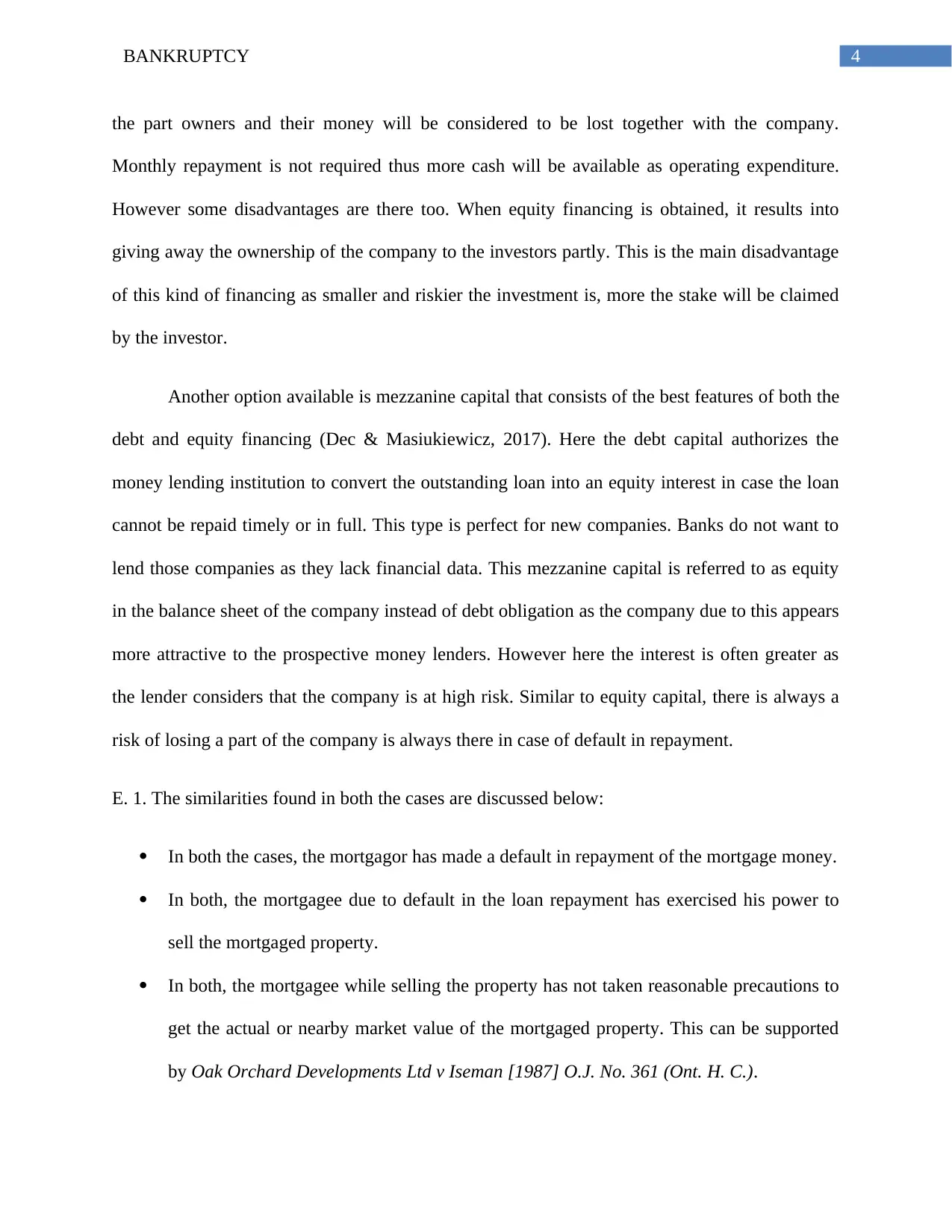
4BANKRUPTCY
the part owners and their money will be considered to be lost together with the company.
Monthly repayment is not required thus more cash will be available as operating expenditure.
However some disadvantages are there too. When equity financing is obtained, it results into
giving away the ownership of the company to the investors partly. This is the main disadvantage
of this kind of financing as smaller and riskier the investment is, more the stake will be claimed
by the investor.
Another option available is mezzanine capital that consists of the best features of both the
debt and equity financing (Dec & Masiukiewicz, 2017). Here the debt capital authorizes the
money lending institution to convert the outstanding loan into an equity interest in case the loan
cannot be repaid timely or in full. This type is perfect for new companies. Banks do not want to
lend those companies as they lack financial data. This mezzanine capital is referred to as equity
in the balance sheet of the company instead of debt obligation as the company due to this appears
more attractive to the prospective money lenders. However here the interest is often greater as
the lender considers that the company is at high risk. Similar to equity capital, there is always a
risk of losing a part of the company is always there in case of default in repayment.
E. 1. The similarities found in both the cases are discussed below:
In both the cases, the mortgagor has made a default in repayment of the mortgage money.
In both, the mortgagee due to default in the loan repayment has exercised his power to
sell the mortgaged property.
In both, the mortgagee while selling the property has not taken reasonable precautions to
get the actual or nearby market value of the mortgaged property. This can be supported
by Oak Orchard Developments Ltd v Iseman [1987] O.J. No. 361 (Ont. H. C.).
the part owners and their money will be considered to be lost together with the company.
Monthly repayment is not required thus more cash will be available as operating expenditure.
However some disadvantages are there too. When equity financing is obtained, it results into
giving away the ownership of the company to the investors partly. This is the main disadvantage
of this kind of financing as smaller and riskier the investment is, more the stake will be claimed
by the investor.
Another option available is mezzanine capital that consists of the best features of both the
debt and equity financing (Dec & Masiukiewicz, 2017). Here the debt capital authorizes the
money lending institution to convert the outstanding loan into an equity interest in case the loan
cannot be repaid timely or in full. This type is perfect for new companies. Banks do not want to
lend those companies as they lack financial data. This mezzanine capital is referred to as equity
in the balance sheet of the company instead of debt obligation as the company due to this appears
more attractive to the prospective money lenders. However here the interest is often greater as
the lender considers that the company is at high risk. Similar to equity capital, there is always a
risk of losing a part of the company is always there in case of default in repayment.
E. 1. The similarities found in both the cases are discussed below:
In both the cases, the mortgagor has made a default in repayment of the mortgage money.
In both, the mortgagee due to default in the loan repayment has exercised his power to
sell the mortgaged property.
In both, the mortgagee while selling the property has not taken reasonable precautions to
get the actual or nearby market value of the mortgaged property. This can be supported
by Oak Orchard Developments Ltd v Iseman [1987] O.J. No. 361 (Ont. H. C.).
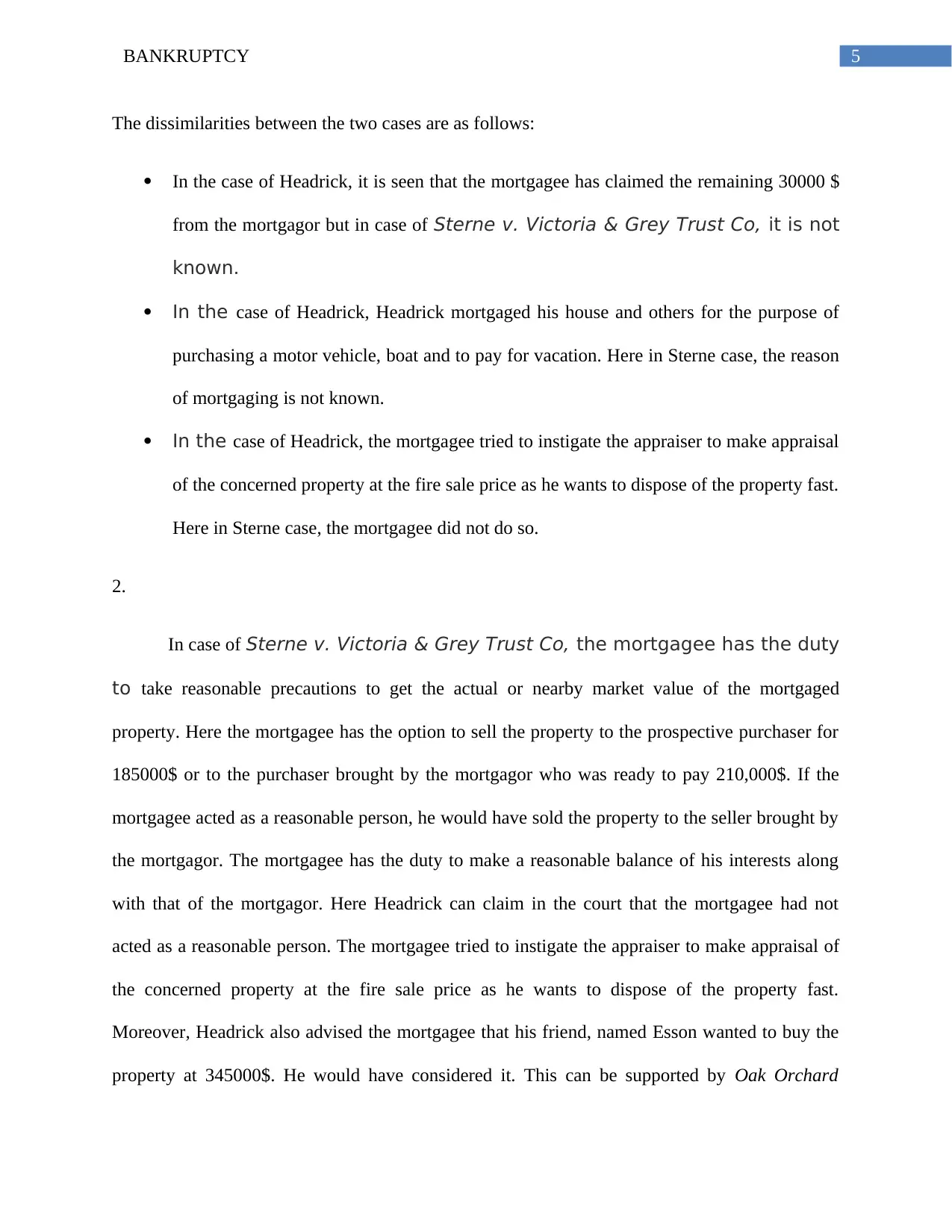
5BANKRUPTCY
The dissimilarities between the two cases are as follows:
In the case of Headrick, it is seen that the mortgagee has claimed the remaining 30000 $
from the mortgagor but in case of Sterne v. Victoria & Grey Trust Co, it is not
known.
In the case of Headrick, Headrick mortgaged his house and others for the purpose of
purchasing a motor vehicle, boat and to pay for vacation. Here in Sterne case, the reason
of mortgaging is not known.
In the case of Headrick, the mortgagee tried to instigate the appraiser to make appraisal
of the concerned property at the fire sale price as he wants to dispose of the property fast.
Here in Sterne case, the mortgagee did not do so.
2.
In case of Sterne v. Victoria & Grey Trust Co, the mortgagee has the duty
to take reasonable precautions to get the actual or nearby market value of the mortgaged
property. Here the mortgagee has the option to sell the property to the prospective purchaser for
185000$ or to the purchaser brought by the mortgagor who was ready to pay 210,000$. If the
mortgagee acted as a reasonable person, he would have sold the property to the seller brought by
the mortgagor. The mortgagee has the duty to make a reasonable balance of his interests along
with that of the mortgagor. Here Headrick can claim in the court that the mortgagee had not
acted as a reasonable person. The mortgagee tried to instigate the appraiser to make appraisal of
the concerned property at the fire sale price as he wants to dispose of the property fast.
Moreover, Headrick also advised the mortgagee that his friend, named Esson wanted to buy the
property at 345000$. He would have considered it. This can be supported by Oak Orchard
The dissimilarities between the two cases are as follows:
In the case of Headrick, it is seen that the mortgagee has claimed the remaining 30000 $
from the mortgagor but in case of Sterne v. Victoria & Grey Trust Co, it is not
known.
In the case of Headrick, Headrick mortgaged his house and others for the purpose of
purchasing a motor vehicle, boat and to pay for vacation. Here in Sterne case, the reason
of mortgaging is not known.
In the case of Headrick, the mortgagee tried to instigate the appraiser to make appraisal
of the concerned property at the fire sale price as he wants to dispose of the property fast.
Here in Sterne case, the mortgagee did not do so.
2.
In case of Sterne v. Victoria & Grey Trust Co, the mortgagee has the duty
to take reasonable precautions to get the actual or nearby market value of the mortgaged
property. Here the mortgagee has the option to sell the property to the prospective purchaser for
185000$ or to the purchaser brought by the mortgagor who was ready to pay 210,000$. If the
mortgagee acted as a reasonable person, he would have sold the property to the seller brought by
the mortgagor. The mortgagee has the duty to make a reasonable balance of his interests along
with that of the mortgagor. Here Headrick can claim in the court that the mortgagee had not
acted as a reasonable person. The mortgagee tried to instigate the appraiser to make appraisal of
the concerned property at the fire sale price as he wants to dispose of the property fast.
Moreover, Headrick also advised the mortgagee that his friend, named Esson wanted to buy the
property at 345000$. He would have considered it. This can be supported by Oak Orchard
⊘ This is a preview!⊘
Do you want full access?
Subscribe today to unlock all pages.

Trusted by 1+ million students worldwide
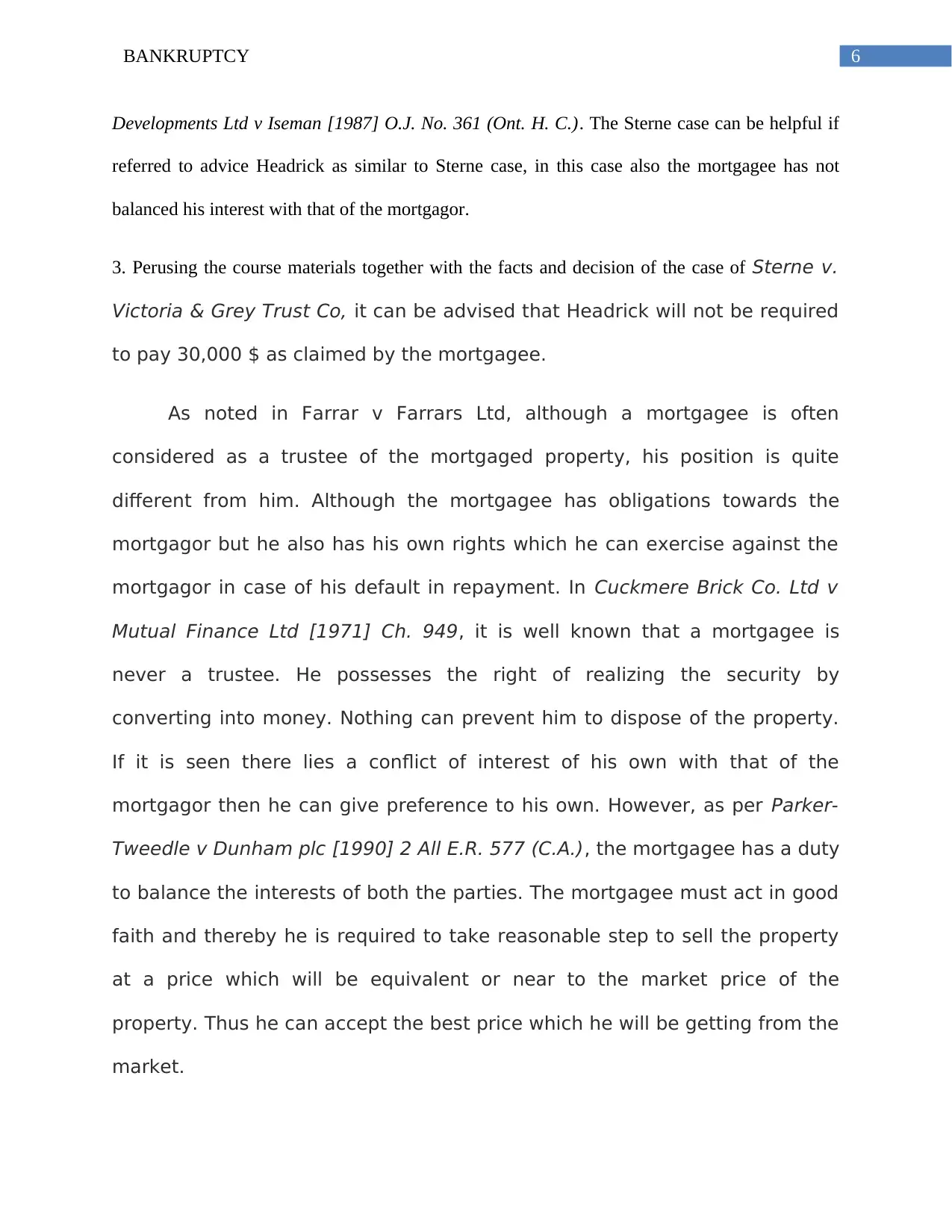
6BANKRUPTCY
Developments Ltd v Iseman [1987] O.J. No. 361 (Ont. H. C.). The Sterne case can be helpful if
referred to advice Headrick as similar to Sterne case, in this case also the mortgagee has not
balanced his interest with that of the mortgagor.
3. Perusing the course materials together with the facts and decision of the case of Sterne v.
Victoria & Grey Trust Co, it can be advised that Headrick will not be required
to pay 30,000 $ as claimed by the mortgagee.
As noted in Farrar v Farrars Ltd, although a mortgagee is often
considered as a trustee of the mortgaged property, his position is quite
different from him. Although the mortgagee has obligations towards the
mortgagor but he also has his own rights which he can exercise against the
mortgagor in case of his default in repayment. In Cuckmere Brick Co. Ltd v
Mutual Finance Ltd [1971] Ch. 949, it is well known that a mortgagee is
never a trustee. He possesses the right of realizing the security by
converting into money. Nothing can prevent him to dispose of the property.
If it is seen there lies a conflict of interest of his own with that of the
mortgagor then he can give preference to his own. However, as per Parker-
Tweedle v Dunham plc [1990] 2 All E.R. 577 (C.A.), the mortgagee has a duty
to balance the interests of both the parties. The mortgagee must act in good
faith and thereby he is required to take reasonable step to sell the property
at a price which will be equivalent or near to the market price of the
property. Thus he can accept the best price which he will be getting from the
market.
Developments Ltd v Iseman [1987] O.J. No. 361 (Ont. H. C.). The Sterne case can be helpful if
referred to advice Headrick as similar to Sterne case, in this case also the mortgagee has not
balanced his interest with that of the mortgagor.
3. Perusing the course materials together with the facts and decision of the case of Sterne v.
Victoria & Grey Trust Co, it can be advised that Headrick will not be required
to pay 30,000 $ as claimed by the mortgagee.
As noted in Farrar v Farrars Ltd, although a mortgagee is often
considered as a trustee of the mortgaged property, his position is quite
different from him. Although the mortgagee has obligations towards the
mortgagor but he also has his own rights which he can exercise against the
mortgagor in case of his default in repayment. In Cuckmere Brick Co. Ltd v
Mutual Finance Ltd [1971] Ch. 949, it is well known that a mortgagee is
never a trustee. He possesses the right of realizing the security by
converting into money. Nothing can prevent him to dispose of the property.
If it is seen there lies a conflict of interest of his own with that of the
mortgagor then he can give preference to his own. However, as per Parker-
Tweedle v Dunham plc [1990] 2 All E.R. 577 (C.A.), the mortgagee has a duty
to balance the interests of both the parties. The mortgagee must act in good
faith and thereby he is required to take reasonable step to sell the property
at a price which will be equivalent or near to the market price of the
property. Thus he can accept the best price which he will be getting from the
market.
Paraphrase This Document
Need a fresh take? Get an instant paraphrase of this document with our AI Paraphraser

7BANKRUPTCY
Here in the present case, it is seen that Esson, a friend of Headrick has
already offered 345000$ which he ignored. Here the mortgagee has acted
recklessly. Hence as per the maxim, “he who seeks equity must do equity”,
the mortgagee will be barred from claiming remaining 30000$ from
Headrick.
F. 1. Issue:
The issue here is to determine the method of protecting the rights of
the newly developed medical product by a pharmaceutical company.
Rules:
Under the Canadian Patent law, there are mainly three criteria that are
to be fulfilled in order to get patent for some invention. Those basic criteria
are utility, novelty and inventiveness. In order to be granted, the invention
must be the first of its kind such that it is not in the market. The invention
must be of use. It should not be such that it has no utility or function. The
invention must be related to a new development or an improvement to a
present technology. When all these conditions are fulfilled, patent will be
granted to the inventor.
Once patent is granted, the invention is owned by the inventor so that
he can exercise exclusive control on its usage. He gains the exclusive right
to use, sell, export or import his invention. All these can be availed to the
inventor.
Here in the present case, it is seen that Esson, a friend of Headrick has
already offered 345000$ which he ignored. Here the mortgagee has acted
recklessly. Hence as per the maxim, “he who seeks equity must do equity”,
the mortgagee will be barred from claiming remaining 30000$ from
Headrick.
F. 1. Issue:
The issue here is to determine the method of protecting the rights of
the newly developed medical product by a pharmaceutical company.
Rules:
Under the Canadian Patent law, there are mainly three criteria that are
to be fulfilled in order to get patent for some invention. Those basic criteria
are utility, novelty and inventiveness. In order to be granted, the invention
must be the first of its kind such that it is not in the market. The invention
must be of use. It should not be such that it has no utility or function. The
invention must be related to a new development or an improvement to a
present technology. When all these conditions are fulfilled, patent will be
granted to the inventor.
Once patent is granted, the invention is owned by the inventor so that
he can exercise exclusive control on its usage. He gains the exclusive right
to use, sell, export or import his invention. All these can be availed to the
inventor.
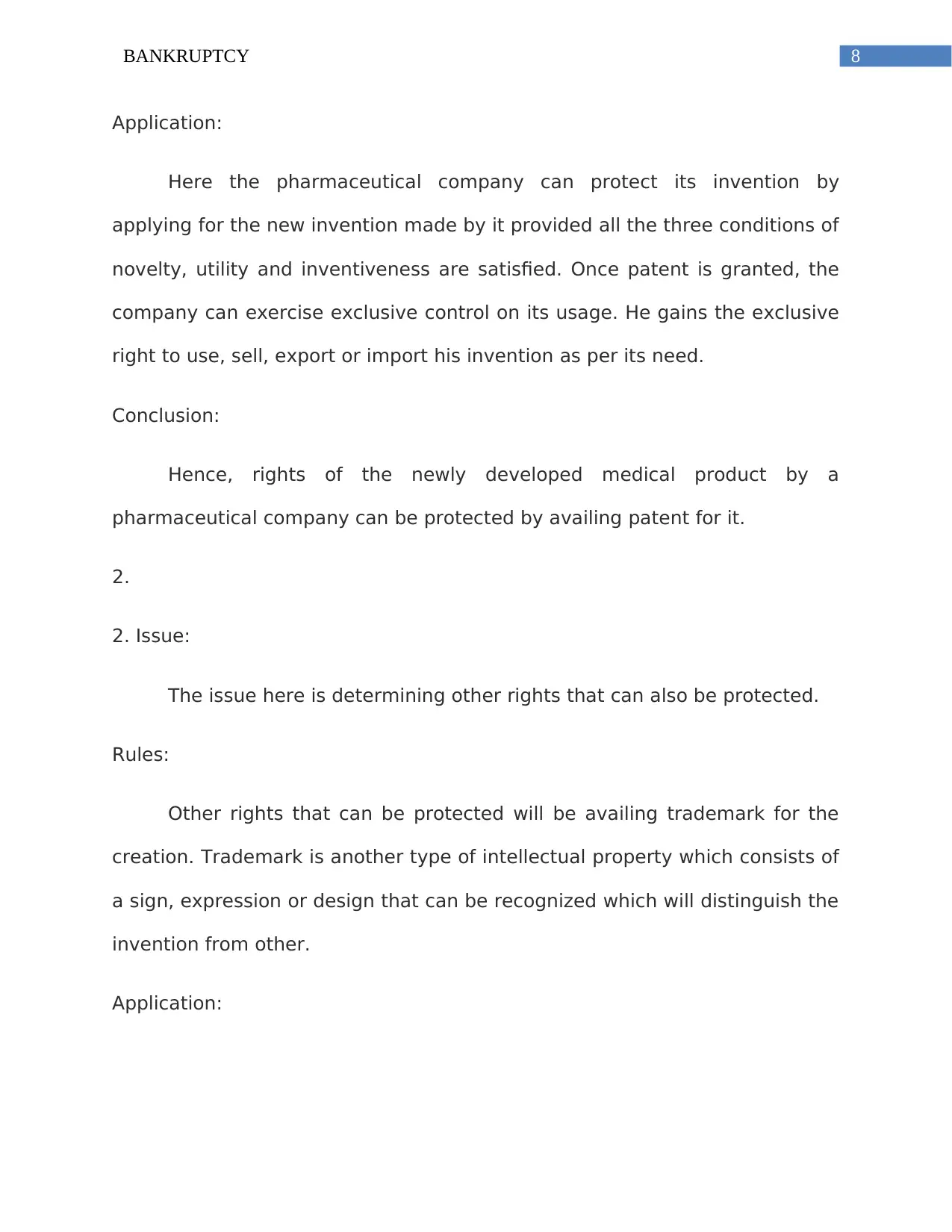
8BANKRUPTCY
Application:
Here the pharmaceutical company can protect its invention by
applying for the new invention made by it provided all the three conditions of
novelty, utility and inventiveness are satisfied. Once patent is granted, the
company can exercise exclusive control on its usage. He gains the exclusive
right to use, sell, export or import his invention as per its need.
Conclusion:
Hence, rights of the newly developed medical product by a
pharmaceutical company can be protected by availing patent for it.
2.
2. Issue:
The issue here is determining other rights that can also be protected.
Rules:
Other rights that can be protected will be availing trademark for the
creation. Trademark is another type of intellectual property which consists of
a sign, expression or design that can be recognized which will distinguish the
invention from other.
Application:
Application:
Here the pharmaceutical company can protect its invention by
applying for the new invention made by it provided all the three conditions of
novelty, utility and inventiveness are satisfied. Once patent is granted, the
company can exercise exclusive control on its usage. He gains the exclusive
right to use, sell, export or import his invention as per its need.
Conclusion:
Hence, rights of the newly developed medical product by a
pharmaceutical company can be protected by availing patent for it.
2.
2. Issue:
The issue here is determining other rights that can also be protected.
Rules:
Other rights that can be protected will be availing trademark for the
creation. Trademark is another type of intellectual property which consists of
a sign, expression or design that can be recognized which will distinguish the
invention from other.
Application:
⊘ This is a preview!⊘
Do you want full access?
Subscribe today to unlock all pages.

Trusted by 1+ million students worldwide
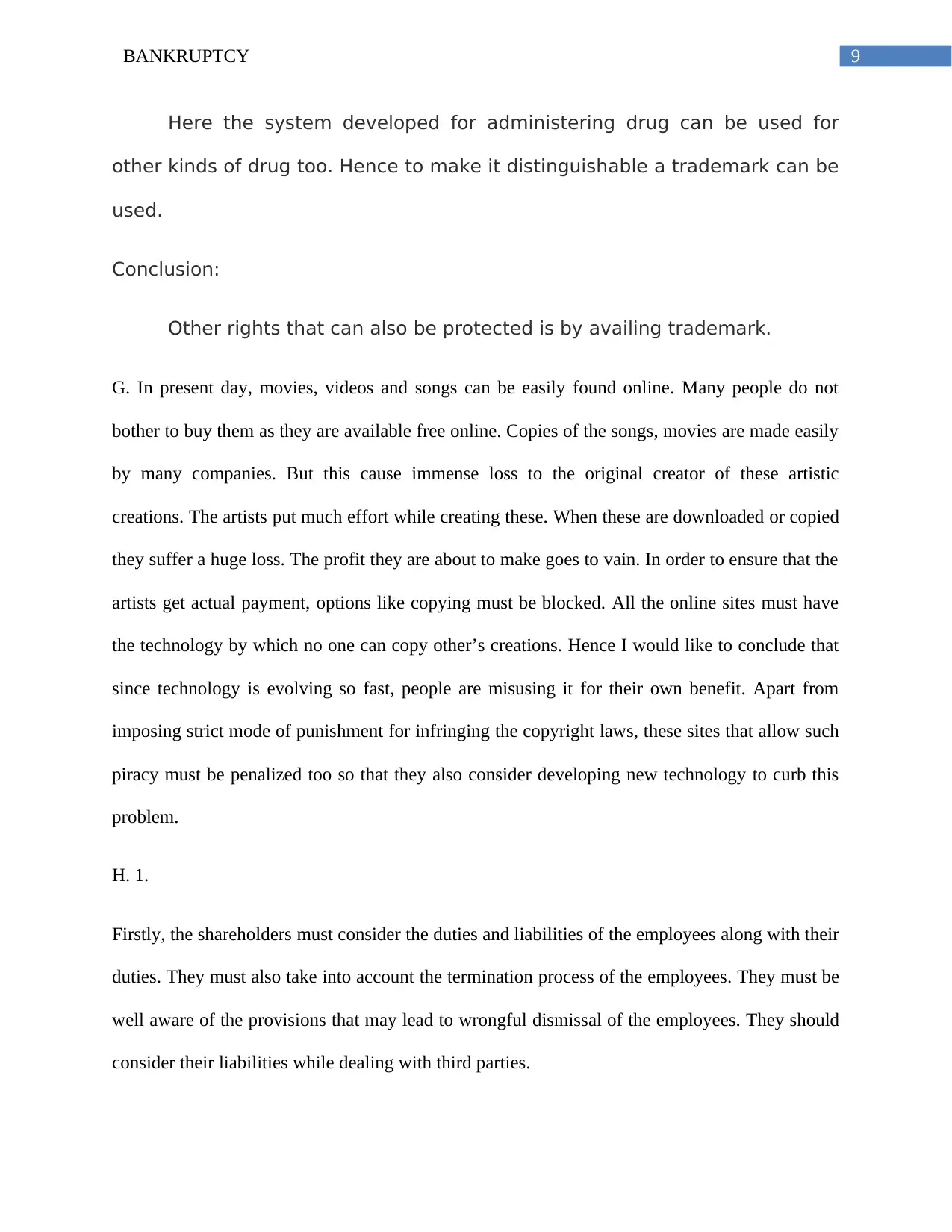
9BANKRUPTCY
Here the system developed for administering drug can be used for
other kinds of drug too. Hence to make it distinguishable a trademark can be
used.
Conclusion:
Other rights that can also be protected is by availing trademark.
G. In present day, movies, videos and songs can be easily found online. Many people do not
bother to buy them as they are available free online. Copies of the songs, movies are made easily
by many companies. But this cause immense loss to the original creator of these artistic
creations. The artists put much effort while creating these. When these are downloaded or copied
they suffer a huge loss. The profit they are about to make goes to vain. In order to ensure that the
artists get actual payment, options like copying must be blocked. All the online sites must have
the technology by which no one can copy other’s creations. Hence I would like to conclude that
since technology is evolving so fast, people are misusing it for their own benefit. Apart from
imposing strict mode of punishment for infringing the copyright laws, these sites that allow such
piracy must be penalized too so that they also consider developing new technology to curb this
problem.
H. 1.
Firstly, the shareholders must consider the duties and liabilities of the employees along with their
duties. They must also take into account the termination process of the employees. They must be
well aware of the provisions that may lead to wrongful dismissal of the employees. They should
consider their liabilities while dealing with third parties.
Here the system developed for administering drug can be used for
other kinds of drug too. Hence to make it distinguishable a trademark can be
used.
Conclusion:
Other rights that can also be protected is by availing trademark.
G. In present day, movies, videos and songs can be easily found online. Many people do not
bother to buy them as they are available free online. Copies of the songs, movies are made easily
by many companies. But this cause immense loss to the original creator of these artistic
creations. The artists put much effort while creating these. When these are downloaded or copied
they suffer a huge loss. The profit they are about to make goes to vain. In order to ensure that the
artists get actual payment, options like copying must be blocked. All the online sites must have
the technology by which no one can copy other’s creations. Hence I would like to conclude that
since technology is evolving so fast, people are misusing it for their own benefit. Apart from
imposing strict mode of punishment for infringing the copyright laws, these sites that allow such
piracy must be penalized too so that they also consider developing new technology to curb this
problem.
H. 1.
Firstly, the shareholders must consider the duties and liabilities of the employees along with their
duties. They must also take into account the termination process of the employees. They must be
well aware of the provisions that may lead to wrongful dismissal of the employees. They should
consider their liabilities while dealing with third parties.
Paraphrase This Document
Need a fresh take? Get an instant paraphrase of this document with our AI Paraphraser
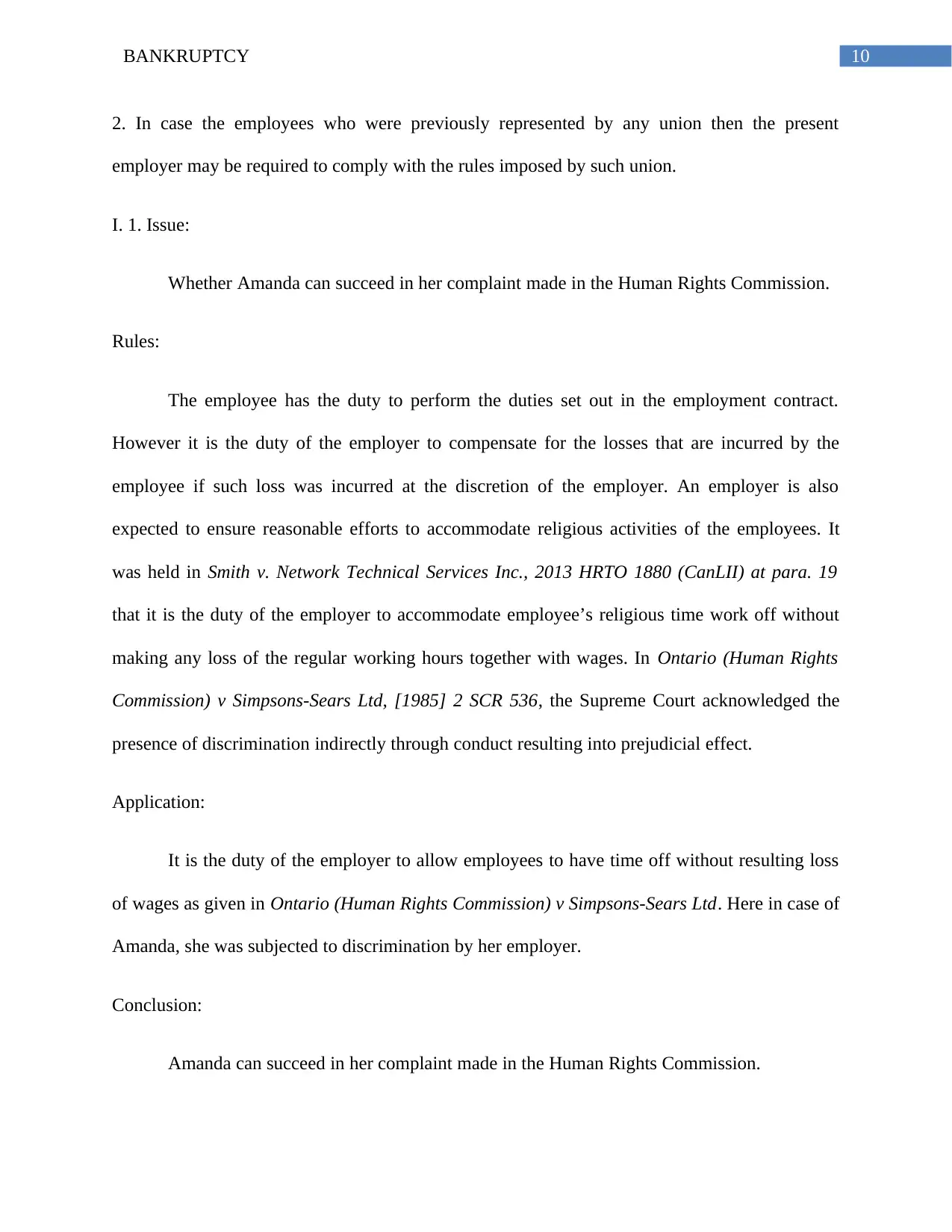
10BANKRUPTCY
2. In case the employees who were previously represented by any union then the present
employer may be required to comply with the rules imposed by such union.
I. 1. Issue:
Whether Amanda can succeed in her complaint made in the Human Rights Commission.
Rules:
The employee has the duty to perform the duties set out in the employment contract.
However it is the duty of the employer to compensate for the losses that are incurred by the
employee if such loss was incurred at the discretion of the employer. An employer is also
expected to ensure reasonable efforts to accommodate religious activities of the employees. It
was held in Smith v. Network Technical Services Inc., 2013 HRTO 1880 (CanLII) at para. 19
that it is the duty of the employer to accommodate employee’s religious time work off without
making any loss of the regular working hours together with wages. In Ontario (Human Rights
Commission) v Simpsons-Sears Ltd, [1985] 2 SCR 536, the Supreme Court acknowledged the
presence of discrimination indirectly through conduct resulting into prejudicial effect.
Application:
It is the duty of the employer to allow employees to have time off without resulting loss
of wages as given in Ontario (Human Rights Commission) v Simpsons-Sears Ltd. Here in case of
Amanda, she was subjected to discrimination by her employer.
Conclusion:
Amanda can succeed in her complaint made in the Human Rights Commission.
2. In case the employees who were previously represented by any union then the present
employer may be required to comply with the rules imposed by such union.
I. 1. Issue:
Whether Amanda can succeed in her complaint made in the Human Rights Commission.
Rules:
The employee has the duty to perform the duties set out in the employment contract.
However it is the duty of the employer to compensate for the losses that are incurred by the
employee if such loss was incurred at the discretion of the employer. An employer is also
expected to ensure reasonable efforts to accommodate religious activities of the employees. It
was held in Smith v. Network Technical Services Inc., 2013 HRTO 1880 (CanLII) at para. 19
that it is the duty of the employer to accommodate employee’s religious time work off without
making any loss of the regular working hours together with wages. In Ontario (Human Rights
Commission) v Simpsons-Sears Ltd, [1985] 2 SCR 536, the Supreme Court acknowledged the
presence of discrimination indirectly through conduct resulting into prejudicial effect.
Application:
It is the duty of the employer to allow employees to have time off without resulting loss
of wages as given in Ontario (Human Rights Commission) v Simpsons-Sears Ltd. Here in case of
Amanda, she was subjected to discrimination by her employer.
Conclusion:
Amanda can succeed in her complaint made in the Human Rights Commission.
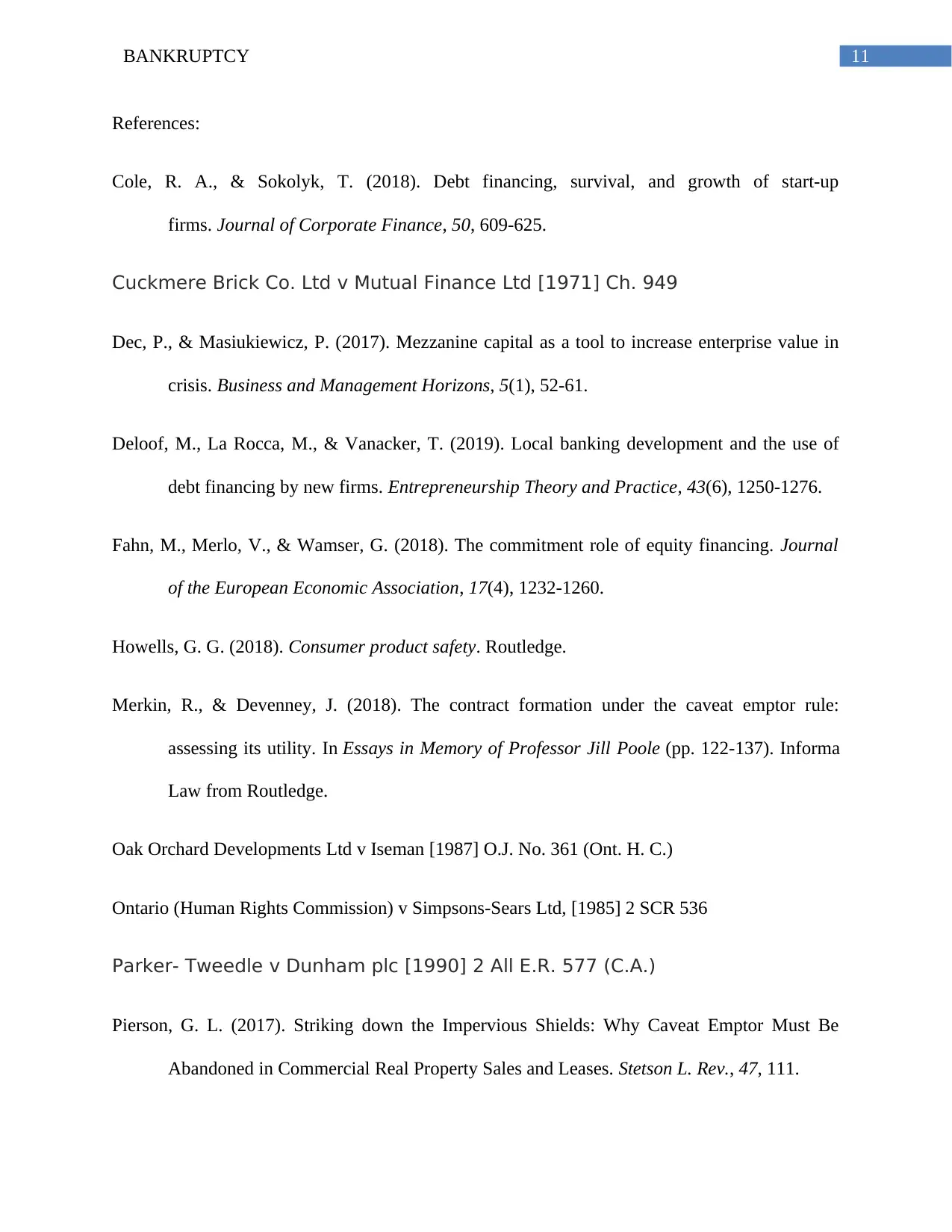
11BANKRUPTCY
References:
Cole, R. A., & Sokolyk, T. (2018). Debt financing, survival, and growth of start-up
firms. Journal of Corporate Finance, 50, 609-625.
Cuckmere Brick Co. Ltd v Mutual Finance Ltd [1971] Ch. 949
Dec, P., & Masiukiewicz, P. (2017). Mezzanine capital as a tool to increase enterprise value in
crisis. Business and Management Horizons, 5(1), 52-61.
Deloof, M., La Rocca, M., & Vanacker, T. (2019). Local banking development and the use of
debt financing by new firms. Entrepreneurship Theory and Practice, 43(6), 1250-1276.
Fahn, M., Merlo, V., & Wamser, G. (2018). The commitment role of equity financing. Journal
of the European Economic Association, 17(4), 1232-1260.
Howells, G. G. (2018). Consumer product safety. Routledge.
Merkin, R., & Devenney, J. (2018). The contract formation under the caveat emptor rule:
assessing its utility. In Essays in Memory of Professor Jill Poole (pp. 122-137). Informa
Law from Routledge.
Oak Orchard Developments Ltd v Iseman [1987] O.J. No. 361 (Ont. H. C.)
Ontario (Human Rights Commission) v Simpsons-Sears Ltd, [1985] 2 SCR 536
Parker- Tweedle v Dunham plc [1990] 2 All E.R. 577 (C.A.)
Pierson, G. L. (2017). Striking down the Impervious Shields: Why Caveat Emptor Must Be
Abandoned in Commercial Real Property Sales and Leases. Stetson L. Rev., 47, 111.
References:
Cole, R. A., & Sokolyk, T. (2018). Debt financing, survival, and growth of start-up
firms. Journal of Corporate Finance, 50, 609-625.
Cuckmere Brick Co. Ltd v Mutual Finance Ltd [1971] Ch. 949
Dec, P., & Masiukiewicz, P. (2017). Mezzanine capital as a tool to increase enterprise value in
crisis. Business and Management Horizons, 5(1), 52-61.
Deloof, M., La Rocca, M., & Vanacker, T. (2019). Local banking development and the use of
debt financing by new firms. Entrepreneurship Theory and Practice, 43(6), 1250-1276.
Fahn, M., Merlo, V., & Wamser, G. (2018). The commitment role of equity financing. Journal
of the European Economic Association, 17(4), 1232-1260.
Howells, G. G. (2018). Consumer product safety. Routledge.
Merkin, R., & Devenney, J. (2018). The contract formation under the caveat emptor rule:
assessing its utility. In Essays in Memory of Professor Jill Poole (pp. 122-137). Informa
Law from Routledge.
Oak Orchard Developments Ltd v Iseman [1987] O.J. No. 361 (Ont. H. C.)
Ontario (Human Rights Commission) v Simpsons-Sears Ltd, [1985] 2 SCR 536
Parker- Tweedle v Dunham plc [1990] 2 All E.R. 577 (C.A.)
Pierson, G. L. (2017). Striking down the Impervious Shields: Why Caveat Emptor Must Be
Abandoned in Commercial Real Property Sales and Leases. Stetson L. Rev., 47, 111.
⊘ This is a preview!⊘
Do you want full access?
Subscribe today to unlock all pages.

Trusted by 1+ million students worldwide
1 out of 13
Your All-in-One AI-Powered Toolkit for Academic Success.
+13062052269
info@desklib.com
Available 24*7 on WhatsApp / Email
![[object Object]](/_next/static/media/star-bottom.7253800d.svg)
Unlock your academic potential
Copyright © 2020–2025 A2Z Services. All Rights Reserved. Developed and managed by ZUCOL.
